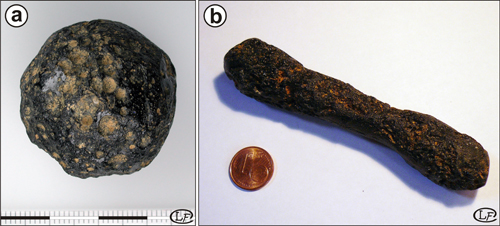Two types of distal impactites are distinguished in the literature (see, e.g., Stöffler and Grieve, 2007), the consolidated ones, namely tektites and microtektites, and the unconsolidated ones, the so-called airfall beds.
1. Tektites and microtektites
Tektites and microtektites are natural glasses, mostly dark green to black in color (see Figure 5), and display a variety of shapes. By definition, microtektites are smaller than 1 mm in size and tektites are larger than 1 mm; some tektites are several centimeters in size (see, e.g., the reviews by O’Keefe, 1963; Koeberl, 1994). Three main groups of tektites have been defined: splash form tektites, aerodynamically shaped tektites, and Muong Nong-type (or layered) tektites. Four tektites strewn fields are known, namely, the North American, Central European, Ivory Coast, and Australasian strewn fields (O’Keefe, 1963). Microtektites occur in deep-sea sediments, in the North American, Ivory Coast, and Australasian strewn fields (see, e.g., Glass, 1967). Recently, microtektites were also described from Antarctica, in a new strewn field, named Victoria Land Transantarctic strewn field (Folco et al., 2008), which might be associated with the Australasian field.
In some cases, relict minerals occur in tektites, such as zircon, rutile, corundum, quartz, chromite, etc. (e.g., Glass, 1970, 1972). Lechatelierite, coesite, and high-temperature breakdown products, such as baddeleyite, have been also characterized in tektites (e.g., Chao, 1963). The impact origin of tektites has been solved only recently, mainly based on geochemical data (e.g., Koeberl and Shirey, 1993) and petrological data. Tektites are formed by melting of terrestrial surficial material during hypervelocity impact. The Ivory Coast tektites (see Figure 5a) are associated with the Bosumtwi crater, the Central European tektites with the Ries structure, and the North American tektites with the Chesapeake Bay crater (e.g., Koeberl, 1994). The Australasian strewn field, only ~0.79-0.80 Ma old (see, Glass and Koeberl, 2006) Ma, has so far no impact structure associated. For more information on tektites and microtektites, see, e.g., O’Keefe, 1963; Barnes, 1990; Glass, 1990; Koeberl, 1994.

2. Airfall beds
Airfall beds are “pelitic sediment with melt spherules, shocked and unshocked clasts” (Stöffler and Grieve, 2007). However, the term of impactoclastic airfall bed should be preferred, as the term of airfall bed is already used for the description of pyroclastic debris layers or ash beds. The Cretaceous-Tertiary boundary, associated with the formation of the Chicxulub impact structure, is one of the best examples of impactoclastic airfall bed (see, e.g., the review by Kring, 2007).
See references on Terrestrial Impactites. |
Navigation
Impact Cratering
Types of Impact Craters
Cratering Mechanics
Terrestrial Impactites
Impact Metamorphism
Proximal Impactites
Distal Impactites |